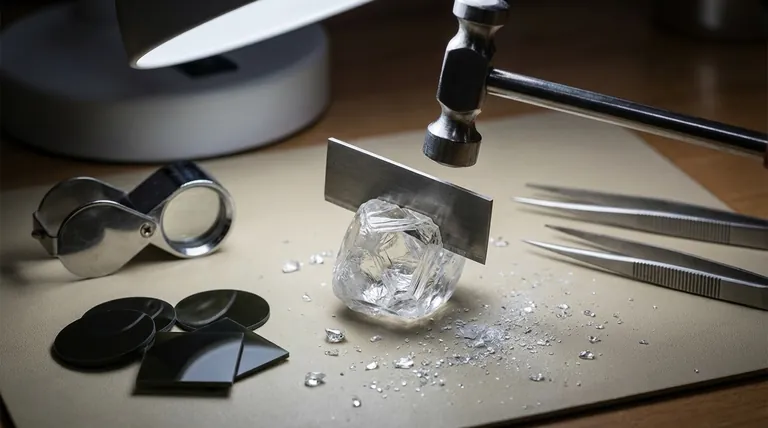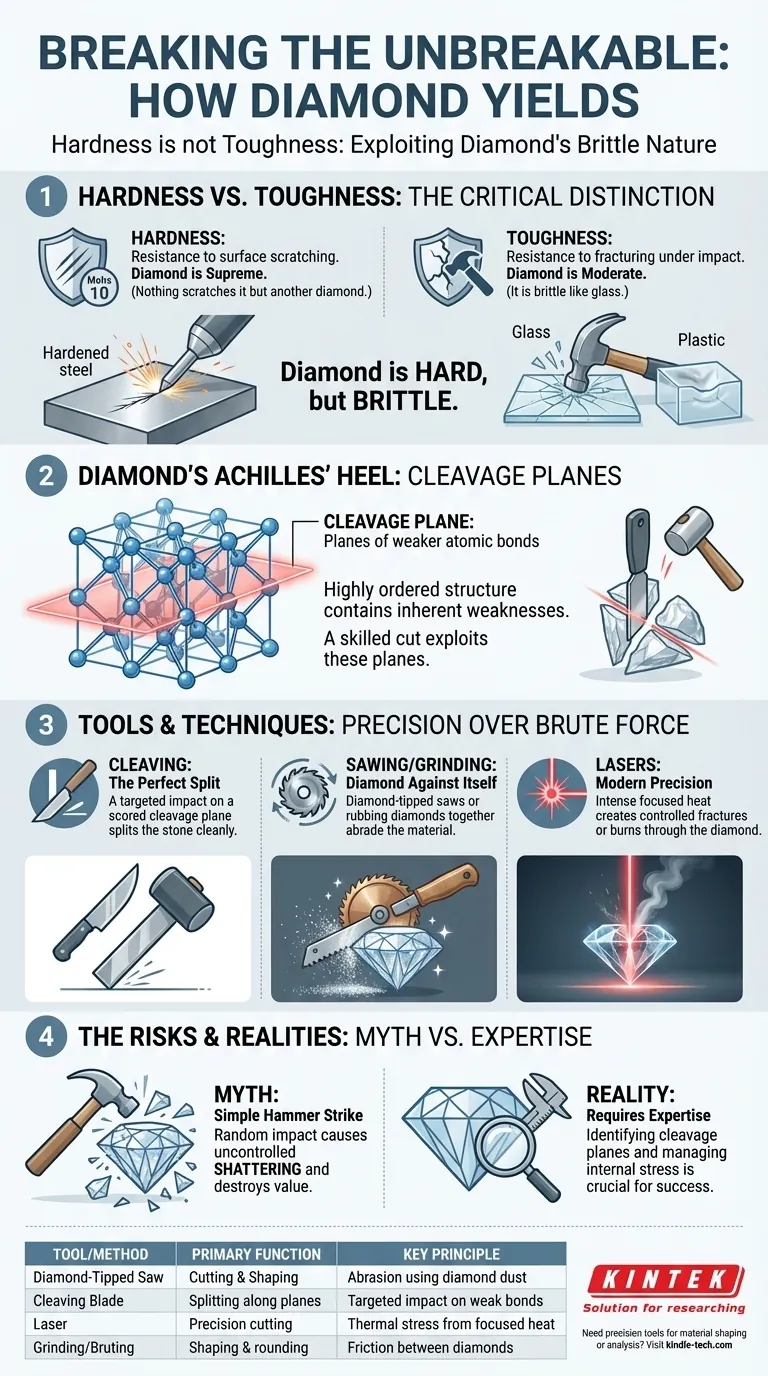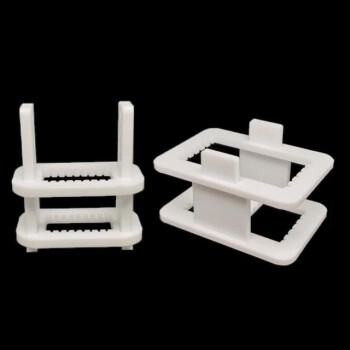To break a diamond, the most common and effective tool used is another diamond. While famed as the hardest natural material, a diamond is not indestructible; it is hard but also brittle. Its unique crystal structure contains inherent weaknesses that can be exploited with force, precision, and specialized tools to cleave, saw, or shape it.
A diamond's reputation as "unbreakable" stems from its supreme hardness (resistance to scratching), not its toughness (resistance to fracture). Its brittleness and specific atomic weaknesses, known as cleavage planes, are precisely what allow it to be intentionally cut and broken.
Why "The Hardest Material" Can Still Break
The ability to shape a diamond hinges on understanding its specific physical properties. Its strength is directional and conditional, not absolute.
The Critical Difference: Hardness vs. Toughness
Hardness is a measure of a material's resistance to surface scratching. On the Mohs scale of hardness, diamond scores a 10, meaning virtually nothing can scratch it except another diamond.
Toughness, however, is a material's ability to resist fracturing or shattering when impact is applied. In this regard, diamond is only moderately tough.
Think of the difference between glass and hard plastic. A glass plate is much harder than plastic and will easily scratch it. But a sharp blow from a hammer will shatter the glass, while the tougher plastic might only deform or dent. Diamond behaves much like that super-hard glass.
Diamond's Achilles' Heel: Cleavage Planes
A diamond is a crystal with a highly ordered, repeating atomic structure. While the carbon-to-carbon bonds are exceptionally strong, they are not equally strong in all directions.
This structure results in cleavage planes—flat surfaces along which the atomic bonds are weaker. A skilled diamond cutter can identify these planes.
A sharp, targeted impact delivered parallel to a cleavage plane can split the diamond cleanly with surprisingly little force. This is not breaking the strong bonds, but separating the weaker ones between atomic layers.
The Tools and Techniques for Shaping Diamond
Shaping diamond is less about brute force and more about precision engineering that exploits its weaknesses.
Cleaving: The Art of the Perfect Split
The classic method for splitting a large rough diamond is cleaving. A cutter first scratches a small groove into the diamond's surface along a cleavage plane using another diamond.
Then, a steel blade is placed in the groove, and a single, sharp tap from a mallet delivers the necessary impact. If done correctly, the diamond splits perfectly along the predetermined plane.
Sawing and Grinding: Using Diamond Against Itself
When a diamond needs to be cut against its cleavage plane, sawing is used. The "saw" is a thin disc, typically made of phosphor bronze, whose edge is coated with fine diamond dust.
As the wheel spins at high speed, the thousands of tiny diamond particles slowly abrade the larger stone, grinding it away. A similar process, called bruting or grinding, involves rubbing two diamonds against each other to shape them.
Modern Precision: The Role of Lasers
Today, high-powered lasers are a primary tool for diamond cutting. A laser beam can be focused to heat a tiny spot on the diamond to an extreme temperature.
This intense thermal stress creates a controlled fracture. Lasers can also be used to burn a path directly through the stone, offering unparalleled precision for complex shapes without relying on cleavage planes.
The Risks and Realities of Diamond Cutting
The idea that you can smash a diamond with a common tool is a dangerous oversimplification. The process is one of extreme skill and risk.
The Myth of the Simple Hammer Strike
Randomly striking a diamond with a hammer is far more likely to cause it to shatter into multiple, low-value fragments than to produce a clean break.
Without targeting a cleavage plane, the uncontrolled force will propagate through the crystal lattice in unpredictable ways, destroying the stone's internal structure.
The Requirement for Precision
Identifying cleavage planes requires years of expertise. A miscalculation of even a fraction of a degree can lead to a disastrous fracture, ruining the gemstone. The value of a diamond is tied to its size and clarity, both of which are jeopardized by an improper cut.
Internal Stress and Inclusions
Most diamonds contain internal flaws or areas of strain created during their formation deep within the Earth. These invisible stress points can make the diamond behave unpredictably during cutting, adding another layer of risk to the process.
Making the Right Choice for Your Goal
Understanding how to break a diamond is about understanding its fundamental properties, not just finding a tool.
- If your primary focus is the physics: The key takeaway is the crucial distinction between surface hardness (scratch resistance) and structural toughness (impact resistance).
- If your primary focus is the practical process: Recognize that shaping diamond requires exploiting its crystal weaknesses with specialized tools, such as other diamonds or lasers, applied with immense precision.
True mastery of any material comes not from knowing its reputation, but from a deep understanding of its strengths and, more importantly, its weaknesses.

Summary Table:
| Tool/Method | Primary Function | Key Principle |
|---|---|---|
| Diamond-Tipped Saw | Cutting & Shaping | Abrasion using diamond dust |
| Cleaving Blade | Splitting along cleavage planes | Targeted impact on weak atomic planes |
| Laser | Precision cutting & controlled fracture | Thermal stress from focused heat |
| Grinding/Bruting | Shaping & rounding | Friction between diamonds |
Need precision tools for material shaping or analysis? KINTEK specializes in high-quality lab equipment and consumables tailored for demanding applications. Whether you're working with diamonds, ceramics, or advanced composites, our tools deliver the accuracy and reliability your research requires. Contact us today to explore how KINTEK can support your laboratory’s unique needs!
Visual Guide

Related Products
- CVD Diamond Cutting Tool Blanks for Precision Machining
- Precision Wire Saw Laboratory Cutting Machine with 800mm x 800mm Workbench for Diamond Single Wire Circular Small Cutting
- Metallographic Specimen Mounting Machine for Laboratory Materials and Analysis
- CVD Diamond Domes for Industrial and Scientific Applications
- Laboratory Disc Rotary Mixer for Efficient Sample Mixing and Homogenization
People Also Ask
- What are the raw materials for CVD diamonds? A seed, a gas, and the science of crystal growth.
- What are some ethical issues with diamond mining? Uncover the Hidden Costs of Your Gemstone
- What are the environmental issues with diamond mining? Uncover the True Ecological and Human Cost
- What is the difference between metallic and non-metallic coating? A Guide to Sacrificial vs. Barrier Protection
- Will CVD diamond change color? Discover the Science of Permanent, Stable Color



















